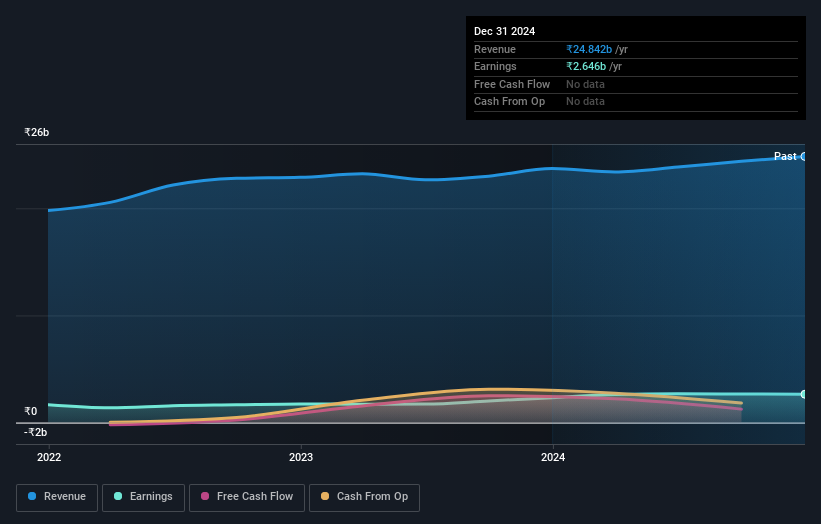Public companies are Balmer Lawrie & Co. Ltd.'s (NSE:BALMLAWRIE) biggest owners and were rewarded after market cap rose by ₹3.3b last week
Key Insights
- Balmer Lawrie's significant public companies ownership suggests that the key decisions are influenced by shareholders from the larger public
- 62% of the company is held by a single shareholder (Balmer Lawrie Investments Limited)
- Using data from company's past performance alongside ownership research, one can better assess the future performance of a company
To get a sense of who is truly in control of Balmer Lawrie & Co. Ltd. (NSE:BALMLAWRIE), it is important to understand the ownership structure of the business. And the group that holds the biggest piece of the pie are public companies with 62% ownership. Put another way, the group faces the maximum upside potential (or downside risk).
As a result, public companies were the biggest beneficiaries of last week’s 11% gain.
In the chart below, we zoom in on the different ownership groups of Balmer Lawrie.
See our latest analysis for Balmer Lawrie

What Does The Institutional Ownership Tell Us About Balmer Lawrie?
Institutional investors commonly compare their own returns to the returns of a commonly followed index. So they generally do consider buying larger companies that are included in the relevant benchmark index.
As you can see, institutional investors have a fair amount of stake in Balmer Lawrie. This suggests some credibility amongst professional investors. But we can't rely on that fact alone since institutions make bad investments sometimes, just like everyone does. It is not uncommon to see a big share price drop if two large institutional investors try to sell out of a stock at the same time. So it is worth checking the past earnings trajectory of Balmer Lawrie, (below). Of course, keep in mind that there are other factors to consider, too.

Hedge funds don't have many shares in Balmer Lawrie. The company's largest shareholder is Balmer Lawrie Investments Limited, with ownership of 62%. This essentially means that they have extensive influence, if not outright control, over the future of the corporation. For context, the second largest shareholder holds about 1.3% of the shares outstanding, followed by an ownership of 1.2% by the third-largest shareholder.
While it makes sense to study institutional ownership data for a company, it also makes sense to study analyst sentiments to know which way the wind is blowing. We're not picking up on any analyst coverage of the stock at the moment, so the company is unlikely to be widely held.
Insider Ownership Of Balmer Lawrie
While the precise definition of an insider can be subjective, almost everyone considers board members to be insiders. Management ultimately answers to the board. However, it is not uncommon for managers to be executive board members, especially if they are a founder or the CEO.
I generally consider insider ownership to be a good thing. However, on some occasions it makes it more difficult for other shareholders to hold the board accountable for decisions.
Our data cannot confirm that board members are holding shares personally. Not all jurisdictions have the same rules around disclosing insider ownership, and it is possible we have missed something, here. So you can click here learn more about the CEO.
General Public Ownership
The general public-- including retail investors -- own 33% stake in the company, and hence can't easily be ignored. While this group can't necessarily call the shots, it can certainly have a real influence on how the company is run.
Public Company Ownership
We can see that public companies hold 62% of the Balmer Lawrie shares on issue. It's hard to say for sure but this suggests they have entwined business interests. This might be a strategic stake, so it's worth watching this space for changes in ownership.
Next Steps:
I find it very interesting to look at who exactly owns a company. But to truly gain insight, we need to consider other information, too. For example, we've discovered 1 warning sign for Balmer Lawrie that you should be aware of before investing here.
If you would prefer check out another company -- one with potentially superior financials -- then do not miss this free list of interesting companies, backed by strong financial data.
NB: Figures in this article are calculated using data from the last twelve months, which refer to the 12-month period ending on the last date of the month the financial statement is dated. This may not be consistent with full year annual report figures.
Have feedback on this article? Concerned about the content? Get in touch with us directly. Alternatively, email editorial-team (at) simplywallst.com.
This article by Simply Wall St is general in nature. We provide commentary based on historical data and analyst forecasts only using an unbiased methodology and our articles are not intended to be financial advice. It does not constitute a recommendation to buy or sell any stock, and does not take account of your objectives, or your financial situation. We aim to bring you long-term focused analysis driven by fundamental data. Note that our analysis may not factor in the latest price-sensitive company announcements or qualitative material. Simply Wall St has no position in any stocks mentioned.
 Wall Street Journal
Wall Street Journal